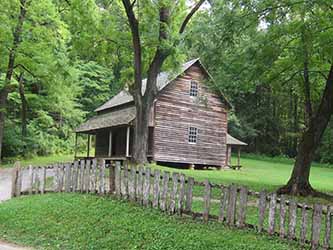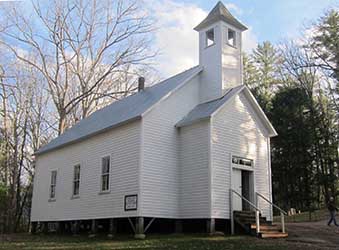
Historic Structures in Cades Cove
 |
 |
| Tipton Place | Cades Cove Missionary Baptist Church |
Cades Cove Historic Buildings & Structures:
Barn at Gregg Cable Place
Barn at Tipton Place
Blacksmith Shop
Cable Corn Crib
Cades Cove Methodist Church
Cades Cove Missionary Baptist Church
Cades Cove Primitive Baptist Church
Cantilever Barn
Corn Crib
Carter Shields Cabin
Dan Lawson Cabin
Elijah Oliver Cabin
Gregg Cable House
Henry Whitehead Cabin
John Oliver Cabin
John P. Cable Grist Mill
Pioneer Wagon
Smokehouse
Sorghum Mill
The Tipton Place
Wild Hog Trap
Cades Cove -- Only a few cabins and other historical structures remain in Cades Cove. White settlers followed the Indians to the Cove, and their sign is everywhere: buildings and roads, apple trees and fences, daffodils and footpaths. Cades Cove is an open air museum that preserves some of the material culture of those who last lived there. In 1850 the cove supported 685 members of 137 households.
An eleven-mile loop road through Cades Cove follows many of the grades and turns of the old wagon roads, fording a stream now and then.
Settlers first entered the Cove legally after an Indian treaty transferred the land to the State of Tennessee in 1819. Year after year they funneled through the gaps, driven by whatever haunted them behind or drew them in front, until they spilled over the floor and up the slopes. Most of them traced their way down the migration route from Virginia into east Tennessee (now more or less Interstate 81). Tuckaleechee (modern Townsend) was the last point of supply before the leap into Cades Cove. A few years later pioneers moved directly over the mountains from North Carolina. They all came equipped with personal belongings, and the tools and skills of an Old World culture, enriched with what they learned from the Indians.
The people of the Cove did not enter, settle and become shut off from the rest of humanity. They were not discovered by Park developers, still living a pioneer lifestyle. From the beginning they kept up through the newspapers, regular mail service, circuit riding preachers, and buying and selling trips to Tuckaleechee, Maryville and Knoxville. They went to wars and war came to them. They attended church and school, and college if financially able. A resident physician was here most of the time from the 1830s on. Telephones rang in a few Cove homes about as early as anywhere else (1896).
| WELCOME TO GREAT SMOKY MOUNTAINS NATIONAL PARK Trip Ideas Great Smoky Mountains Facts Policies Institute at Tremont Order Your Free Visitor's Guide Transportation & Airports Local News Photo Tours • Fall Photo Tour • Roaring Fork Motor Nature Trail • Smoky Mountain Fall Foliage • Fall Foliage at Clingmans Dome • Fall Colors in nearby Villages • Fall in Wears Valley • Best Fall Hikes in the Smokies |
WHAT TO DO Attractions Biking Fishing Hiking Outdoor Adventure Scenic Drives and Rides Shopping Heritage, History, & Culture Nature Activities |
WHERE TO STAY Bed & Breakfast Cabins Camping Condos Hotels WHERE TO EAT |
4 SEASONS Winter Spring Summer Fall WEDDINGS Wedding Services Honeymoon Cabins |
Surrounding Towns: • Cherokee • Gatlinburg • Maggie Valley • Pigeon Forge • Townsend • Wears Valley CONTACT Contact Add Your Site Advertise |
© 1996-2025 by Image Builders | Privacy Policy